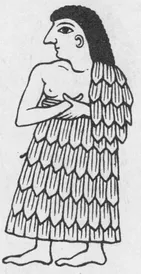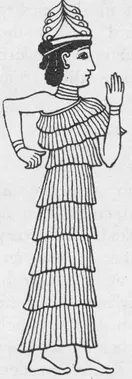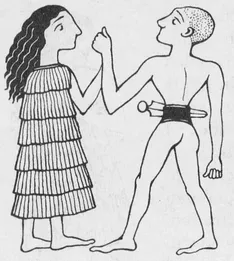
eBook - ePub
Ancient Greek, Roman & Byzantine Costume
Mary G. Houston
This is a test
Buch teilen
- 208 Seiten
- English
- ePUB (handyfreundlich)
- Über iOS und Android verfügbar
eBook - ePub
Ancient Greek, Roman & Byzantine Costume
Mary G. Houston
Angaben zum Buch
Buchvorschau
Inhaltsverzeichnis
Quellenangaben
Über dieses Buch
This scrupulously researched and abundantly illustrated book includes 315 drawings based on renderings by artists of the period to achieve utmost accuracy and authenticity.
Included are elaborate examples of Aegean costume, Doric and Ionic styles of dress for women, Greek and Roman armor, graceful and intricately arranged Roman togas, the tunica — roomy, wide-sleeved apparel; and the pallium, a cloak-like garment. Ornate vestments of the Eastern Orthodox Church and Byzantine costumes are carefully described and portrayed, as are styles of hairdressing, jewelry, and other decorative elements.
An excellent reference for the history classroom, the volume also includes instructions and flat patterns showing the cut of sample garments, making it easy for costume designers to reproduce period apparel. This book will be valuable as well to costume historians and art students interested in the development of representative art.
Included are elaborate examples of Aegean costume, Doric and Ionic styles of dress for women, Greek and Roman armor, graceful and intricately arranged Roman togas, the tunica — roomy, wide-sleeved apparel; and the pallium, a cloak-like garment. Ornate vestments of the Eastern Orthodox Church and Byzantine costumes are carefully described and portrayed, as are styles of hairdressing, jewelry, and other decorative elements.
An excellent reference for the history classroom, the volume also includes instructions and flat patterns showing the cut of sample garments, making it easy for costume designers to reproduce period apparel. This book will be valuable as well to costume historians and art students interested in the development of representative art.
Häufig gestellte Fragen
Wie kann ich mein Abo kündigen?
Gehe einfach zum Kontobereich in den Einstellungen und klicke auf „Abo kündigen“ – ganz einfach. Nachdem du gekündigt hast, bleibt deine Mitgliedschaft für den verbleibenden Abozeitraum, den du bereits bezahlt hast, aktiv. Mehr Informationen hier.
(Wie) Kann ich Bücher herunterladen?
Derzeit stehen all unsere auf Mobilgeräte reagierenden ePub-Bücher zum Download über die App zur Verfügung. Die meisten unserer PDFs stehen ebenfalls zum Download bereit; wir arbeiten daran, auch die übrigen PDFs zum Download anzubieten, bei denen dies aktuell noch nicht möglich ist. Weitere Informationen hier.
Welcher Unterschied besteht bei den Preisen zwischen den Aboplänen?
Mit beiden Aboplänen erhältst du vollen Zugang zur Bibliothek und allen Funktionen von Perlego. Die einzigen Unterschiede bestehen im Preis und dem Abozeitraum: Mit dem Jahresabo sparst du auf 12 Monate gerechnet im Vergleich zum Monatsabo rund 30 %.
Was ist Perlego?
Wir sind ein Online-Abodienst für Lehrbücher, bei dem du für weniger als den Preis eines einzelnen Buches pro Monat Zugang zu einer ganzen Online-Bibliothek erhältst. Mit über 1 Million Büchern zu über 1.000 verschiedenen Themen haben wir bestimmt alles, was du brauchst! Weitere Informationen hier.
Unterstützt Perlego Text-zu-Sprache?
Achte auf das Symbol zum Vorlesen in deinem nächsten Buch, um zu sehen, ob du es dir auch anhören kannst. Bei diesem Tool wird dir Text laut vorgelesen, wobei der Text beim Vorlesen auch grafisch hervorgehoben wird. Du kannst das Vorlesen jederzeit anhalten, beschleunigen und verlangsamen. Weitere Informationen hier.
Ist Ancient Greek, Roman & Byzantine Costume als Online-PDF/ePub verfügbar?
Ja, du hast Zugang zu Ancient Greek, Roman & Byzantine Costume von Mary G. Houston im PDF- und/oder ePub-Format sowie zu anderen beliebten Büchern aus Conception & Stylisme. Aus unserem Katalog stehen dir über 1 Million Bücher zur Verfügung.
Information
Thema
ConceptionThema
StylismeCHAPTER I
AEGEAN COSTUME
THE term Aegean is now used to describe that civilization which had its fountain-head in Crete and its latest development on the Greek mainland. The period here covered is c. 2100 B.C. till 1100 B.C. The Palace of Minos, at Knossos, in Crete and the ancient City of Mycenae on the Greek mainland have given rise to the words Minoan and Mycenaean, as the great wealth of archaeological discovery yielded up by these two sites justifies the usage. Sir A. Evans has divided Aegean civilization into three periods and has laid down the dates for each as follows: “Early Minoan” 3400 B.C.–2100 B.C., “Middle Minoan” 2100 B.C.–1580 B.C., and “ Late Minoan,” which includes Mycenaean, at 1580 B.C.–1100 B.C. He relates the above three periods to some extent with the periods of the “ Old,” “Middle” and commencement of the “ New Kingdom ” in Egypt. (Dating —Old Kingdom 3400 B.C., Middle c. 2375 B.C., and New 1580 B.C.–610 B.C. See Cambridge Ancient History.)
The costume of Minoan Crete and of Mycenaean Greece has now become almost as familiar to us as that of Ancient Egypt and Assyria, but until some sixty odd years ago the very existence of the brilliant civilization, of which it is a part, was hidden from mankind. The discoveries of Schliemann at Mycenae and near-by Tiryns and later those of Sir A. Evans and others in Crete held perhaps the greatest archaeological surprise the world had so far known. It was, indeed, the light thrown on Aegean costume, more especially that of the women, which gave most cause for astonishment. Hitherto the simple draperies of the ancient Egyptians and Assyrians led us to imagine that these and none other were the garments of the ancient world—when, therefore, there emerged the earlier Minoan ladies wearing costumes apparently distended by crinolines and their descendants of the later Minoan and Mycenaean Periods in tight-fitting jackets and flounced skirts, all previous conceptions as to the dress of this remote period were dissipated. The origin of this elaborate style of costume must be assigned in the main to the island of Crete itself but there are influences from the outside world which cannot be ignored. Professor Childe in his book The Most Ancient East tells us that on the walls of prehistoric Spanish cave-shelters there are drawings which show women who are wearing “ bell-shaped skirts.” Again in the matter of flounces the same authority cites the “ kaunakes ” as a woollen material where the threads of the web hang down in loops giving the appearance of flounces. This flounced material was characteristic of the costume of the ancient Sumerians and is considered to have been originally made from the skin of a sheep with the fleece left on; afterwards this was imitated in weaving. In Mesopotamian lands it survived as the costume of the gods after ordinary men and women had taken to plain woven draperies, and it is very frequently seen on cylinder-seals from Mesopotamia where gods are represented. Small objects like seals are easily transported, and some of them having travelled to Crete (one found at Platanos in Crete shows a costume similar to Fig. 2 dating c. 2000 B.C.) would suggest the idea of flounces for the dress of persons of distinction. It will be of interest to compare two examples of Mesopotamian costume with an early Aegean illustration. Fig. 1 is from a bas-relief which is now in the Louvre and which has been dated c. 2900 B.C. Here Ur-Nina, Patesi (High Priest) of Lagash, is represented with his family. Fig. 1, said by one authority (Waddell) to be his daughter “ Lidda ” and by another (Rostovtzeff) to be his prime minister “Dudu,” is wearing the characteristic Sumerian skirt, which in this early example may be of actual sheepskin; there is an extra wrap covering one shoulder. Fig. 2 is from a Mesopotamian seal-impression (c. 2000 B.C.). It represents a minor goddess, and in this case the costume is the “kaunakes ” woven woollen stuff with flounced effect. Here the smaller shawl entirely covers the upper part of the body with the exception of the right shoulder. Fig. 3 shows a woman wearing a flounced cloak with one arm free. This is a betrothal scene from an ivory cylinder found near family. Fig. 1, said by one authority (Waddell) to be his daughter “ Lidda ” and by another (Rostovtzeff) to be his prime minister “Dudu,” is wearing the characteristic Sumerian skirt, which in this early example may be of actual sheepskin; there is an extra wrap covering one shoulder. Fig. 2 is from a Mesopotamian seal-impression (c. 2000 B.C.). It represents a minor goddess, and in this case the costume is the “kaunakes ” woven woollen stuff with flounced effect. Here the smaller shawl entirely covers the upper part of the body with the exception of the right shoulder. Fig. 3 shows a woman wearing a flounced cloak with one arm free. This is a betrothal scene from an ivory cylinder found near Knossos and is of early Middle Minoan period (c. 2100 B.C.). It can be noted here that the male figure is nude except for a belt (to which a dagger is attached) and a sheath which depends from the belt in front. (Owing to the lack of detail in the original the belt has been supplied from another early Minoan figure of the same date.) It is almost unavoidable, when describing Minoan costume, to refrain from giving that of the women prominence of place owing to the fact that in the earlier periods Minoan men were almost nude, and even in the later epochs, except on some occasions of ceremony, wore only a small kilt or abbreviated apron depending from the waist-belt back and front.

Fig. 1.

Fig. 2.

Fig. 3.
STYLE I.
Before dismissing the subject of foreign influence on Minoan styles the proximity of the ancient civilization of Egypt to that of Crete must not be overlooked. At a very early period in Egyptian history we find that a cloak enveloping the whole figure was not unusual as an article of dress, and it has been suggested that this may have been the origin of certain costumes found at Petsofa in Crete, which illustrate the first definite style of Minoan costume and are of the early Middle Minoan Period. Sir A. Evans considers that a long cloak, as worn by Cretan women, was cut out “after the manner of a cope” (compare Etruscan semi-circular “toga”). A girdle was passed round the waist over the cloak and knotted in front; also holes were cut to allow the arms to emerge. Fig. 4a is a drawing made from an artist’s lay figure upon which a cloak, cut out on the plan of a cope, has been draped after the manner suggested by Sir A. Evans. In the above sketch the drapery used for this “ cope” or cloak was a thick cotton poplin material (such as is customarily used for window curtains) and the miniature lay-figure was a little over one foot in height. If an .actual woman of average height were draped in a cloak made from either thick woollen felted cloth or from leather, the effect would be similar and there would be no need to distend the bottom of the garment with a crinoline or hoop. Fig. 4b shows the cloak as a flat pattern; its diameter would, of course, depend on the height of the wearer. Fig. 5 is from a statuette found at Petsofa and of early Middle Minoan Period. Here we have a costume possibly cut on the lines of Figs. 4a and b or perhaps developed from that into a fitted bodice with skirt attached, which latter is either cut with gores narrowing at the waist or gathered into it. There is also a striped decoration upon the skirt which has the appearance of applique work. This, if of leather, would certainly help to stiffen it and so assist the crinoline-like silhouette. The “ Medici collar” effect at the back of the neck is seen also in Fig. 4a and is the result of the “cope-like” cutting out. The padded and knotted girdle somewhat resembles that of the “Snake Goddess” at Figs. 7d and e though in the la...